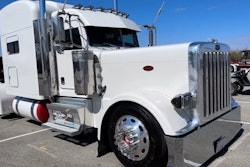Drive, by Nathan Clement
“It’s been at least four years since the idea hit me,” says Nathan Clement. “It hit me when most ideas do, and that’s when I’m driving.” Sound familiar? Clement is the author/illustrator behind Drive, a new book for young children that focuses on a profession you know well.
It’s about a “little boy’s dad going to work and driving a truck,” as Indiana Truck Sales & Service sales manager Terry Garsey puts it. Garsey served as informal consultant to Clement over the years as he developed Drive. Clement himself describes the portrait of the father in the book as that of a “working-class man as hero in his family and on the road” with the potential to serve as a much-needed salve to the battered public perception of the American truck driver.
If “working-class hero” sounds like a far cry from the mainstream media image of the truck driver’s profession these days, that’s because it is, says Garsey. “I’m 57, but when I was 10, being a truck driver was considered a good profession. There was no one looking down their nose at drivers. The image was a lot better.”
Clement came at Drive from a lifetime on the periphery of the industry. While he was never a driver himself, he was, like so many children of the late 1960s and early 1970s, immersed in the pop culture of the big-truck driver. Furthermore, a close older cousin has been an owner-operator all his adult life, and he regularly took Clement and his brother out on runs. “At age 5 my brother could identify every truck by sight,” he says. “We all had CB handles. My brother was ‘Little Sodbuster.'”

Fast-forward 30 years, and Clement’s a graphic designer and freelance illustrator based in Indianapolis, but his in-laws are in Chicago, where he and his family drive north on I-65 regularly to visit. It’s a high-traffic haul for big trucks. “In the middle of one of these trips,” Clement says, “being a little annoyed by all the trucks, truthfully, it struck me that every one of them had somebody in it with some family at home. I spent the next two or three hours mulling it over.” Those thoughts bloomed over the years, during which time Clement met Garsey, consulted with budding long-haul drivers at a local truck-driving school (“change the alarm clock from 5 a.m. to 4 a.m. on the first page,” one said, and Clement did), and met the publisher of Front Street Books, based in Asheville, N.C.
The end result, Drive, is an innovatively wholesome take on a basic day-in-the-life story, combining simple, realistic storytelling from the point of view of a truck driver’s son with Clement’s own “digital airbrush” style, as he calls his method of illustration. He typically starts with small thumbnail sketches, then progresses to more detailed hand drawings modeled on photographs. Then, in Adobe Illustrator, he creates digital art utilizing the program’s myriad tools. It is a mechanical method of illustration that allowed him to unite form and content, he says. The final pages have a somewhat futuristic look while retaining a painterly quality, in keeping with both the industry’s rapid technological advance and many truck owners’ pride in their rigs’ look.
And that wasn’t the only outcome of his work.
“Now, when I’m driving, I’m looking at all the trucks around me and seeing their details,” Clement says. He’s also come to a greater appreciation of the potential held within his book to perform a restoration of the truck driver’s image in the public mind.
“If books like this, for such a young age,” says Garsey, “can promote the positive image of the truck driver, that’s great! Not everybody will grow up to sit in front of a computer. Work’s still got to be done to make those service jobs possible.”
Says Clement, “We believe a book such as this will ignite excitement in kids again for the profession.” According to the publisher, it’s suitable for 2- to 8-year-olds, and it’s available through the usual retailers. In a large hardbound edition, Drive lists for $16.95 (discounted at $12.71) at Amazon.com.
Clement recently brought a signed copy by Garsey’s office to give to Garsey’s 7-year-old son. “I was really proud of Nathan after I got the book and looked through it. It’s a simple story and well-done,” says Garsey. “You never know what could come of something like this. I don’t know how Bob the Builder came about, but it made somebody a lot of money.”
–Todd Dills
Big Music
Trucker DJ combines love for trucking and bluegrass
The title of larger-than-life radio personality “Big Al” Weekley’s second album of trucking music, Always in It for the Long Haul, says it all about his lifelong career in trucking and music.
Weekley, 45, of Parkersburg, W.Va., is best known as a DJ for KRVN radio in Lexington, Neb., where he hosts the “Big Al Bluegrass Program” every Saturday night and his “Gospel Americana” show each Sunday morning. Weekley’s history in radio and music gives him plenty of credibility in the broadcasting business, but it is his “big” presence on the air that listeners like to hear, especially at night, when he says he gets calls from as far away as Anchorage, Alaska.
“Everything runs around the trucking industry,” he says. His father ran a construction company when Weekley was growing up, and at age 14, he began driving for his father.
“My dad wasn’t feeling good, so I hauled equipment and oil rigs. I’ve been doin’ it ever since,” he says. Weekley says he grew up listening to radio shows on a transistor radio his grandmother bought him. “I used to listen to Big John Trimble, a DJ for WRVA in Richmond, Va.,” he recalls.
As Weekley began to drive full-time, he listened to Trimble more and more on the road. In 1986 he got up the courage to call the DJ and play a bluegrass song from his band for him.
“That was a big thing,” he says, laughing.
He wanted to sing live on another radio show at Ohio University, so he and his band went down and sang on the air. “We weren’t that good,” he says. “I mean, it was bad!” But he landed a job with the university radio station that lasted four years. Meanwhile, he continued to drive trucks.
It was then that friend and mentor Rex Osbourne, who was like a father to Weekley, officially dubbed him “Big Al.”
“He was 4’8″, and I was 6’1″,” Weekley says with a laugh.
Trimble let Weekley put on a bluegrass program on Saturdays at 4 a.m., and his calling to a career on the airwaves began.
“John and Rex gave me the energy – the willpower – to do this,” he says. “John got me my first trip backstage at the Grand Ole Opry.”
Weekley was writing his own songs by then, and his inspiration and motivation grew into a passion for music and trucking. Not only did he write or co-write eight of the songs on Always in It for the Long Haul, he does vocals as well. He worked with songwriter Cliff Abbot, current director of Driver Development at Southern Cal Transport in Birmingham, Ala. The CD features one of Abbott’s songs, “Ode to Billy Big Rigger,” a comical look at the “supertrucker” drivers know all too well.
A highlight of Weekley’s career was driving a truck for four years with Manheim Steamroller’s Christmas tours.
“I’ve stayed in hotels and mansions and had coffee with homeless people – I’ve seen both sides of the world,” he says. “It’s been a fight to do what I want to do. I wanted to be different, and I guess I am.”
He enjoys all aspects of his job, especially the late-night talks with drivers across America. “Those families and ranchers and drivers have brought me into their lives,” he says. “It’s a great education. There’s a lot of good people out there.”
Visit Big Al Weekley’s website at www.bigalweekley.net, where you can purchase a copy of his CD and check out fan sites and updates from Big Al himself.
–Sarah Thomson
Newbie’s Guide to Trucking
Driver pens manual to help fellow truckers who are just starting out
Trucker Toby Bogard’s encounters with inexperienced drivers led him to write and self-publish his first book, on how to survive in what he calls “the best industry in the world.”
A truck driver for six years, now with Contract Freighters Inc. (now Con-Way Truckload), Bogard found inspiration for his trucking manual, On the Big Road, while sitting in a Petro truckstop in Virginia in 2004, drinking a cup of joe and swapping stories with fellow drivers. A driver down on his luck asked Bogard if he would help out with a meal or a couple of dollars. Bogard, 35, of Crossville, Tenn., not only bought him a hot dinner but sat down with him and began going over the pay stubs the driver had accumulated.
It turned out the driver didn’t understand how advances in the trucking industry worked. The driver was spending more than he was earning and pledging miles to his company that he wasn’t driving.
Earlier in his career, Bogard himself had trouble keeping up with money. He was spending an exorbitant amount of money on food alone, he says. His new book draws on his experience and tips and tricks proffered by other drivers for those just starting out in the industry.
“It’s a compilation of things I’ve learned,” Bogard says, “and it didn’t just come from me.” While writing it, Bogard haunted truckstops armed with paper and pen, interviewing drivers as they came in for dinner or coffee. He has great respect for truckers who have been in the business for years, with proven success in balancing family, finances and business.
“These are the guys that made it,” he says. “What better place to look for experience?”
On the Big Road covers a wide range of topics, beginning with advice on developing a healthy mind, body and spirit, and then giving practical, everyday advice for living successfully on the road. Bogard is especially passionate about his spiritual life and encourages others, no matter what religion, to develop spirituality within themselves.
“If you have a positive spiritual foundation, you’re going to look at things entirely differently,” he says. “I struggle with it like most people. I’m not perfect by any means. But if you have a positive spirituality, there’s no room for negativity.”
His family – his wife, 13-year-old son Walker and 12-year-old twins Darian and Ariana – is the foundation of his life, he says.
“These people are my security net and my support group,” he says. “I love to be Daddy.”
For more information on Bogard’s book and his upcoming works, Semi-Aware and Truck Drivers Are Mushrooms, e-mail him at [email protected].
–Sarah Thomson











